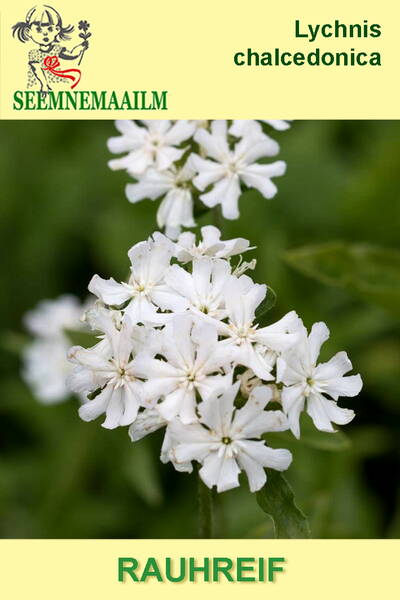Your shopping cart is empty!
Maltese cross "Rauhreif"
Lychnis chalcedonica f. albiflora
2.79€
Ex Tax: 2.25€
Ex Tax: 2.25€
White maltese cross "Rauhreif" - Lychnis chalcedonica f. albiflora.
Decorative and deciduous, unpretentious perennial.
Family: Caryophyllaceae.
Origin: Eastern Europe, Eastern Asia (open forests, roadsides).
Flowering plant height: 90-120 cm.
Distance between plants: 30 cm.
Natural flowering period: June - July.
Blooms in the year of sowing.
Foliage: ovate to lanceolate, opposite, sessile, spiny, light green.
Winter hardiness zones: Z4 - Z8.
Location: winter-hardy. Unpretentious. They prefer open sunny places. They do not tolerate stagnant water.
Care: the culture is responsive to 2-3 times the application of mineral fertilizers. Shelter for the winter is not required.
Diseases and pests: Lychnis can be affected by root rots, loose smut, leaf spots, rust, aphids, leaf rollers and slobbering pennies.
Reproduction: seeds, cuttings (double forms) and dividing the bush. 1.0 g = 2900 seeds.
Sowing of seeds and division is carried out in the spring. Sow in April - July in open ground. The optimal temperature for germination is +18°C. Shoots appear 18-24 days after sowing. For more uniform germination, cold post-sowing stratification for a month is recommended. Plants are grown in one place for 4-5 years. After this period, in the fall or spring, the bushes are pricked out, divided into 3-5 parts depending on the power of development and planted at a distance of 25 cm. At the beginning of summer, young shoots that have grown to 20-25 cm are cut into cuttings and rooted using conventional technology. Rooted cuttings are planted in a permanent place in late August - early September.
Use: for group plantings, they do not stand well when cut.
Decorative and deciduous, unpretentious perennial.
Family: Caryophyllaceae.
Origin: Eastern Europe, Eastern Asia (open forests, roadsides).
Flowering plant height: 90-120 cm.
Distance between plants: 30 cm.
Natural flowering period: June - July.
Blooms in the year of sowing.
Foliage: ovate to lanceolate, opposite, sessile, spiny, light green.
Winter hardiness zones: Z4 - Z8.
Location: winter-hardy. Unpretentious. They prefer open sunny places. They do not tolerate stagnant water.
Care: the culture is responsive to 2-3 times the application of mineral fertilizers. Shelter for the winter is not required.
Diseases and pests: Lychnis can be affected by root rots, loose smut, leaf spots, rust, aphids, leaf rollers and slobbering pennies.
Reproduction: seeds, cuttings (double forms) and dividing the bush. 1.0 g = 2900 seeds.
Sowing of seeds and division is carried out in the spring. Sow in April - July in open ground. The optimal temperature for germination is +18°C. Shoots appear 18-24 days after sowing. For more uniform germination, cold post-sowing stratification for a month is recommended. Plants are grown in one place for 4-5 years. After this period, in the fall or spring, the bushes are pricked out, divided into 3-5 parts depending on the power of development and planted at a distance of 25 cm. At the beginning of summer, young shoots that have grown to 20-25 cm are cut into cuttings and rooted using conventional technology. Rooted cuttings are planted in a permanent place in late August - early September.
Use: for group plantings, they do not stand well when cut.
Maltese cross. Bot. syn.: Silene chalcedonica (L.) E.H.L.Krause.












